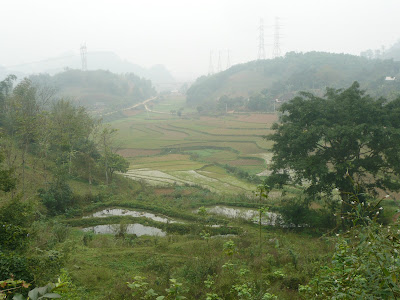After 10 months getting around the city on bicycle, we decided to rent a motorbike for our last three weeks. It's convenient to just hop on the motorbike and take our daughters where they need to go. It's also cheaper -- renting a motorbike is just $55 a month, but we were spending more than that just to have Amali driven by motorcycle taxi back and forth to her school.
But I wouldn't have done otherwise. I figured out that I have averaged 8-10 miles per day on my bike. Mutiplied by about 270 days that we were here in Hanoi, and I have clocked about 2,500 miles by bicycle. I feel more fit than I have in years. One of the things I will miss most is living without a motor vehicle. I love filling the basket on my bike with groceries. I feel safer on my bike too. despite their complete lack of consideration and disregard for safety here, people still generally yield to bicycles.
The streets are lawless -- red lights are mere suggestions. When people do stop for a red light (about 4 seconds after it turns red, red numbers begin to count down until the next green. But no one waits for the green -- at about 3 seconds before, they begin to ride into the intersection, weaving in and out of the oncoming left turns and the people who've continued into the intersection after their lights went red. Most intersections have no signals -- you just have to time it -- so that you don't hit the oncoming or turning traffic, and hopefully avoid pedestrians as well. There is no such thing as a stop sign, and you can turn left or right from any side of any intersection without stopping or yielding. My peripheral vision was well trained this year.
But I wouldn't have done otherwise. I figured out that I have averaged 8-10 miles per day on my bike. Mutiplied by about 270 days that we were here in Hanoi, and I have clocked about 2,500 miles by bicycle. I feel more fit than I have in years. One of the things I will miss most is living without a motor vehicle. I love filling the basket on my bike with groceries. I feel safer on my bike too. despite their complete lack of consideration and disregard for safety here, people still generally yield to bicycles.
The streets are lawless -- red lights are mere suggestions. When people do stop for a red light (about 4 seconds after it turns red, red numbers begin to count down until the next green. But no one waits for the green -- at about 3 seconds before, they begin to ride into the intersection, weaving in and out of the oncoming left turns and the people who've continued into the intersection after their lights went red. Most intersections have no signals -- you just have to time it -- so that you don't hit the oncoming or turning traffic, and hopefully avoid pedestrians as well. There is no such thing as a stop sign, and you can turn left or right from any side of any intersection without stopping or yielding. My peripheral vision was well trained this year.




















